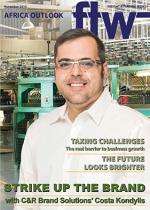Freight volumes in and out
of Africa are expected to
continue growing, according
to the World Bank’s new
Africa’s Pulse, a twice-yearly
analysis of the issues shaping Africa’s
economic prospects.
“Overall, Africa is forecast to
remain one of the world’s three
fastest-growing regions and to
maintain its impressive 20 years
of continuous expansion,” says
Francisco Ferreira, the World Bank’s
chief economist for Africa.
There will be continued
“moderately rapid” growth, with
regional GDP growth projected to
strengthen to 5.2% a year in 2015-16
from 4.6% in 2014.
African countries have succeeded
in diversifying
their economies in
order to continue
growing during
a period of lower
commodity prices
and lower foreign
direct investment
as a result of subdued global
economic conditions.
Significant public investment in
infrastructure, increased agricultural
production and expanding services
in African retail, telecoms,
transportation and finance are
expected to continue to boost growth
in the region, says the report.
However, primary commodities
continue to account for threequarters
of sub-Saharan Africa’s total
goods exports.
“Downside risks that require
enhanced preparedness include
rising fiscal deficits in a number of
countries; economic fallouts from the
activities of terrorist groups such as
Boko Haram and
Al Shabaab and,
most urgently, the
onslaught of the
Ebola epidemic in
West Africa,” says
Ferreira.
In contrast to
much of the rest of the continent,
growth “slowed notably in South
Africa, the region’s second largest
economy, due to structural issues
and low investor confidence,” says
the report.
World Bank
estimates put
South African
economic growth
at a “modest 1%
year-on-year
in the second
quarter of 2014,
its lowest growth
rate since the 2009 financial crisis”.
By contrast, economic activity
strengthened in Nigeria, the region’s
largest economy.
GDP advanced 6.5% year-on-year
in the second quarter, up from a
6.2% in the first quarter.
Growth also remained robust in
many of the region’s low-income
countries, including Cote d’Ivoire,
Ethiopia, Mozambique and
Tanzania.
Big increases in cocoa and rice
production in Cote d’Ivoire boosted
agriculture growth and helped to
sustain the country’s high growth.
Ethiopia’s robust growth
continued to be
supported by
agriculture, as
well as public
investment,
particularly in
infrastructure.
Inflation rates
edged up in a
number of countries, but were more
of a concern in the frontier market
countries that also sustained large
currency depreciations – notably
Ghana.
In a few cases, including Ghana
and Zambia, the fiscal position
remained weak due to increasing
current expenditures, led by rising
wage bills, and in some cases
weaker revenues. Large fiscal
deficits are reducing fiscal buffers
and affecting these countries’ ability
to respond to exogenous shocks.
INSERT 1
6.5% Nigeria’s year-on-year GDP growth
in the second quarter.
INSERT 2
1% South Africa’s year-on-year GDP growth in
the second quarter

